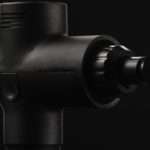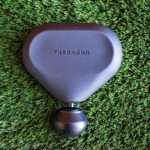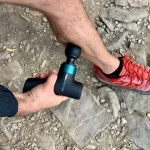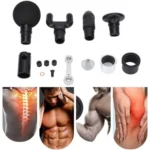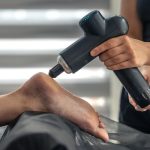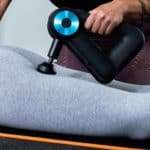A massage gun can be an extremely effective tool for relieving muscle knots. By targeting specific areas of tight muscle tissue, it provides deep percussive therapy that helps break up knots, increase blood flow, and reduce tension.
Unlike foam rollers or lacrosse balls, massage guns offer a more comfortable and convenient way to release knots without requiring as much manual effort. In this guide, I’ll walk you through the best way to use a massage gun for knots so you can experience its benefits for yourself.
The action of massage guns for knots is similar to that of other muscle recovery tools but they provide more affected relief and are easier to use. Muscle knot massagers also allow for easier spot affecting.
When using a massage gun on knots, it is important to start slowly and increase the pressure gradually. It is also important to avoid sensitive areas.
Table of Contents
How Massage Guns Work on Knots
Massage guns can be effective in relieving muscle knots by enhancing blood flow, reducing muscle tension, and improving range of motion.
Massage guns work similarly to other muscle recovery tools, but they offer more targeted relief and require less effort. Their rapid, pulsating movements help loosen tight muscle fibers, improve circulation, and reduce discomfort.
Supporting Research:
- A study published in the Journal of Physical Therapy Science found that massage guns helped reduce muscle soreness and improve flexibility after exercise. PMC
- Another study in BMC Musculoskeletal Disorders demonstrated that massage guns were effective in reducing pain and enhancing mobility in individuals with upper back pain. BioMed Central
While massage guns can be a valuable tool for muscle recovery and pain relief, it’s advisable to consult with a healthcare professional before using them, especially if you have any underlying health condition.

What is a Muscle Knot?
A muscle knot, or trigger point, is a tight, sensitive lump in the muscle caused by tension, overuse, or poor posture. These knots can be painful, stiff, and even limit movement.
One of the best ways to release muscle knots is myofascial release—a technique that applies steady pressure to loosen tight tissue and restore mobility.
If you can’t see a massage therapist, try self-massage using:
— Your hands for targeted pressure
— A foam roller for broad relief
— A massage gun for deep tissue work
Stay consistent, and you’ll keep your muscles loose, pain-free, and flexible! 💪
How to Use a Massage Gun for Knots: Guide
If you’re someone who often suffers from knots, a massage gun can be a game-changer. Using a massage gun on knots can help to break up the tension and help you feel more relaxed. But it’s very important to use it correctly so it doesn’t do any harm.
Safety techniques
There are a few safety techniques to use a massage gun for knots:
- start with the lightest setting and increase the intensity as needed;
- use the massage gun on knots for no more than 15 minutes at a time;
- apply the massage gun to the knot in a circular motion;
- drink plenty of water before and after using the massage gun to help reduce swelling;
- avoid using the massage gun on injured or broken skin.

How to Get a Knot Out of a Muscle: A Step-by-Step Guide
Muscle knots, or trigger points, can cause discomfort, tightness, and restricted movement. Using a massage gun can help release these knots, improve blood flow, and ease muscle tension. Follow these steps to safely and effectively remove muscle knots using a massager.
Step 1: Warm Up Your Muscles 🔥
Before using a massage gun, take a few minutes to warm up your muscles to improve circulation and make the massage more effective.
— Light stretches or a few minutes of walking help loosen up the muscles.
— A warm compress or a quick warm shower can further relax the area.
Step 2: Start with Low Pressure ⚡
Avoid diving straight into intense pressure—this can cause unnecessary pain and muscle tightness.
— Find the trigger point (the tight, sore area).
— Set the massage gun to a low-speed setting and gently place it on the knot.
— Gradually increase intensity based on your comfort level.
Step 3: Target the Trigger Point 🎯
Once you’ve located the muscle knot, focus directly on the area.
— Hold the massage gun over the knot and move it slowly back and forth.
— Apply moderate pressure, but avoid excessive discomfort—it should feel like a deep massage, not sharp pain.
— Hold the massager on the knot for 30 seconds to 2 minutes to encourage muscle release.

Step 4: Work Deeper Into the Knot 💪
If the knot persists, gradually increase the pressure to break up the tight muscle fibers.
— Slowly push the massage gun deeper into the muscle while staying within a comfortable range.
— Pause and hold pressure on the tightest area until you feel the knot begin to loosen.
— Be patient—some knots take longer to fully release.
Step 5: Finish with a Gentle Massage 💆♂️
Once the knot has loosened, transition to a softer, relaxing massage to help with recovery.
— Gradually reduce the intensity of the massage gun.
— Massage the surrounding muscles to promote circulation and prevent soreness.
— Stretch the area afterward to maintain flexibility and prevent future tightness.
Additional Tips for Best Results ✅
— Stay hydrated after using a massage gun to help flush out toxins.
— Use the right attachment (bullet head for deep pressure, round head for larger areas).
— Avoid direct use on bones or joints.
— If knots persist, consider professional massage therapy or physical therapy.
By following these steps, you can effectively relieve muscle knots and keep your body feeling loose, pain-free, and ready for action!
Additional Tips for Best Results
— Drink plenty of water after using a massage gun to help flush out toxins.
— Use the right attachment (bullet head for deep pressure, round head for larger areas).
— Avoid using the massager directly on bones or joints.
— If knots persist, consider professional massage therapy or physical therapy.
By following these steps, you can effectively relieve muscle knots and keep your body feeling loose, pain-free, and ready for action!
Frequently Asked Questions (FAQs)
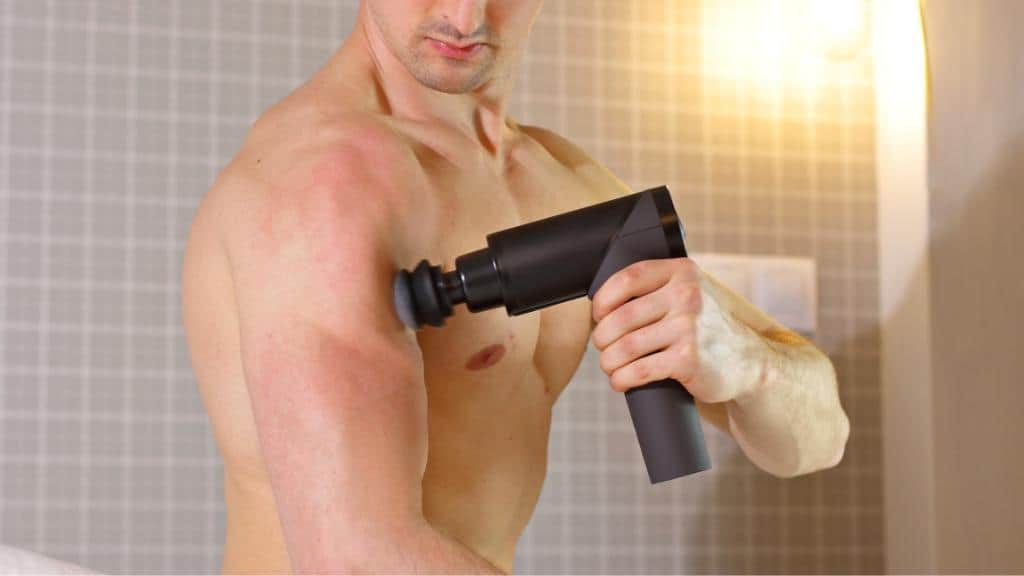
Does vibration help muscle knots?
When applied to the affected area, vibrations can help to break up the knots and improve blood circulation to the area. This can help to reduce inflammation and pain and improve the range of motion.
Is it good to massage muscle knots?
Yes, massage is good for muscle knots. It can help to loosen up your muscles and improve circulation. Massage therapy can also help to reduce pain and stiffness.
Can a back massager get rid of knots?
It depends on the person and the specific knot or knots. However, regular massage with massagers can help to reduce the number and severity of muscle knots.
🔗 Related Links
- How to Reset Massage Gun?
- Can a Massage Gun Help with Cellulite?
- Can a Massage Make you Feel Nauseous?
Bottom Line
If you’re someone who often gets knots in their muscles, a massage gun can be a handy tool to have around. While a traditional massage can help to loosen knots, a massage gun can provide more affected relief. It is important to know how to use the massage gun properly so that you do not cause any further damage to the muscle.
Do you have any experience using a massage gun for knots? Share it in the comments.
📚 References
👉 Percussive Therapy: What It Is and How It Helps — Cleveland Clinic
👉What Are Trigger Points—and How Can Therapy Help? – Very Well Health
👉 What Happens To Your Body When You Use a Massage Gun Every Day? – VeryWellFit
👉 Therapeutic Massage: What It Is and 4 Benefits – Cleveland Clinic
⚠️ Disclaimer:
This article is for informational purposes only and does not constitute medical advice. Always consult with a licensed healthcare provider or certified massage therapist before beginning any new treatment, especially if you have pre-existing health conditions or concerns.



